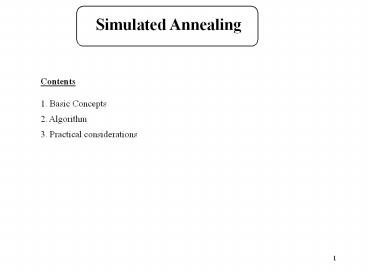Simulated Annealing - PowerPoint PPT Presentation
Title:
Simulated Annealing
Description:
Operations Scheduling with Applications in Manufacturing ... F(Snew) - F(Sold) F has to be minimised c 0 inferior solution - c 0. t ... – PowerPoint PPT presentation
Number of Views:120
Avg rating:3.0/5.0
Title: Simulated Annealing
1
Simulated Annealing
Contents 1. Basic Concepts 2. Algorithm 3.
Practical considerations
2
Literature 1. Modern Heuristic Techniques for
Combinatorial Problems, (Ed) C.Reeves 1995,
McGraw-Hill. Chapter 2. 2. Operations Scheduling
with Applications in Manufacturing and Services,
Michael Pinedo and Xiuli Chao, McGraw Hill,
2000, Chapter 3.6. or Scheduling, Theory,
Algorithms, and Systems, Second
Addition, Michael Pinedo, Prentice Hall, 2002,
Chapter 14.4
3
Basic Concepts
- Allows moves to inferior solutions in order not
to get stuck in a poor local optimum. - ?c F(Snew) - F(Sold) F has to be minimised
inferior solution (?c gt 0) still accepted if
U is a random number from (0, 1) interval t is a
cooling parameter t is initially high - many
moves are accepted t is decreasing - inferior
moves are nearly always rejected
- As the temperature decreases, the probability
of accepting worse moves decreases.
?c gt 0 inferior solution -?c lt 0
4
Algorithm Step 1. k1 Select an initial
schedule S1 using some heuristic and set Sbest
S1 Select an initial temperature t0 gt 0Select a
temperature reduction function ?(t) Step
2. Select Sc?N(Sk) If F(Sbest) lt F(Sc) If F(Sc)
lt F(Sk) then Sk1 Sc else generate a random
uniform number Uk If Uk lt then Sk1
Sc else Sk1 Sk else Sbest Sc Sk1
Sc
5
Step 3. tk ?(t) k k1 If stopping
condition true then STOP else go to Step 2
6
Exercise. Consider the following scheduling
problem 1 dj ?wjTj .
Apply the simulated annealing to the problem
starting out with the3, 1, 4, 2 as an initial
sequence. Neighbourhood all schedules that can
be obtained throughadjacent pairwise
interchanges. Select neighbours within the
neigbourhood at random. Choose ?(t) 0.9
t t0 0.9 Use the following numbers as random
numbers 0.17, 0.91, ...
7
Sbest S1 3, 1, 4, 2 F(S1) ?wjTj 17
1411 120 12 25 461 F(Sbest) t0
0.9 Sc 1, 3, 4, 2 F(Sc) 316 lt F(Sbest)
Sbest 1, 3, 4, 2 F(Sbest) 316 S2 1, 3, 4,
2 t 0.9 0.9 0.81 Sc 1, 3, 2, 4 F(Sc)
340 gt F(Sbest) U1 0.17 gt 1.3510-13 S3
1, 3, 4, 2 t 0.729
8
Sc 1, 4, 3, 2 F(Sc) 319 gt F(Sbest) U3
0.91 gt 0.016 S4 S4 1, 3, 4, 2 t
0.6561 ...
9
- Practical considerations
- Initial temperature
- must be "high"
- acceptance rate 40-60 seems to give good
results in many situations - Cooling schedule
- a number of moves at each temperature
- one move at each temperature
- t ? t ? is typically in the interval 0.9,
0.99
? is typically close to 0
- Stopping condition
- given number of iterations
- no improvement has been obtained for a given
number of iteration































